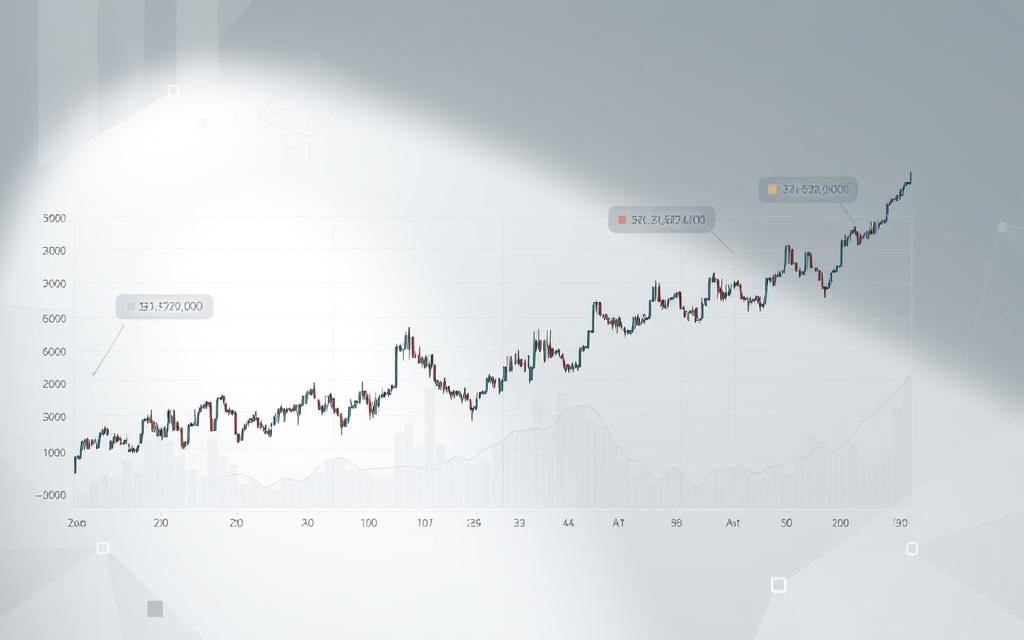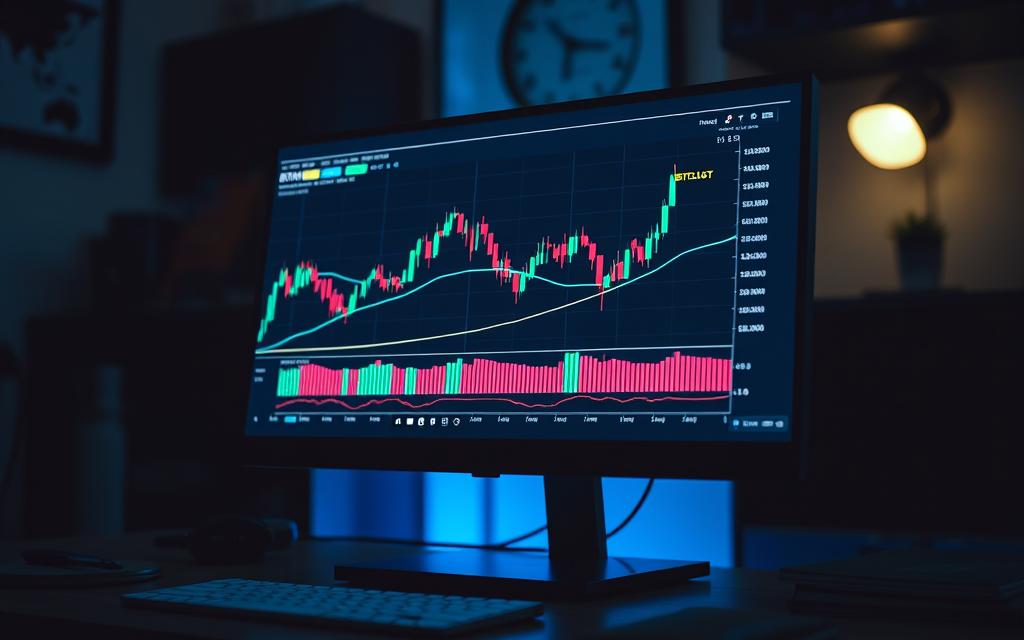Table of Contents
On May 22, Bitcoin hit a new all-time high of $112,000, sparking a heated debate among crypto investors about its future trajectory. While some believe it will continue to soar in the second half of 2025, others warn that it may be overpriced at such high levels.
The current market sentiment is divided, with some analysts predicting a potential price crash, while others foresee continued growth. As investors navigate this uncertainty, understanding the factors influencing Bitcoin’s price is crucial.
This article will examine expert forecasts, technical analysis, and macroeconomic influences to provide a comprehensive analysis of whether Bitcoin is poised for a crash or continued growth in 2024.
The Current State of Bitcoin in 2024
Investors are closely watching Bitcoin’s price action in 2024, anticipating a potential breakout. The cryptocurrency market is highly volatile, and Bitcoin’s price movements are being closely monitored by both retail and institutional investors.
Recent Price Movements and All-Time Highs
Bitcoin’s price has experienced significant fluctuations in 2024, with the cryptocurrency reaching new all-time highs. According to recent data, Bitcoin’s price has been influenced by continued mainstream adoption, with various investor demographics entering the market. As everyone seems to be buying Bitcoin
chart illustrates the recent price movements and highlights the cryptocurrency’s volatility.
The bullish case for Bitcoin is based on its continued adoption and the influx of new investors. This has led to a surge in Bitcoin’s price, with some predictions suggesting that it could continue to rise in the coming months.
Market Sentiment and Investor Behavior
Market sentiment surrounding Bitcoin is mixed, with some investors exhibiting caution while others are optimistic about its future prospects. An analysis of social media trends, search volume data, and other sentiment indicators reveals a high level of public interest in Bitcoin. The fear and greed indexes have fluctuated throughout 2024, providing insights into investor psychology.
Different investor demographics are approaching Bitcoin investments in various ways. While retail investors are buying into the hype, institutional investors are taking a more cautious approach. As one expert notes, “
The current market sentiment is a key driver of Bitcoin’s price movements, and understanding investor behavior is crucial for making informed investment decisions.
“
Understanding Bitcoin’s Volatility: Historical Context
As we look ahead to 2024, analyzing Bitcoin’s past crash cycles and recovery patterns can provide valuable insights into its potential future price movements. Bitcoin’s price volatility has been a hallmark of its existence, with significant implications for investors and the broader cryptocurrency market.
Previous Bitcoin Crash Cycles
Bitcoin has experienced several crash cycles since its inception, with each cycle offering valuable lessons for investors. Historically, these crashes have been triggered by a combination of factors, including regulatory changes, market sentiment shifts, and external economic conditions. For instance, the 2017-2018 crypto bubble burst led to a significant downturn in Bitcoin’s price, which eventually recovered. Analyzing these cycles reveals that Bitcoin’s price tends to follow a pattern of rapid growth followed by sharp corrections, a phenomenon closely watched by traders and investors.
The role of trading volumes and market sentiment during these cycles is also noteworthy. High trading volumes often accompany significant price movements, indicating strong market participation. Moreover, market sentiment, as reflected in investor behavior and attitudes, plays a crucial role in shaping Bitcoin’s price dynamics.
Recovery Patterns After Major Corrections
Recovery patterns after major Bitcoin corrections have been a subject of interest among investors and analysts. Historically, Bitcoin’s recovery has been characterized by a gradual rebuilding of investor confidence, often accompanied by a surge in trading activity. The recovery process is influenced by various factors, including market cycles, regulatory developments, and macroeconomic conditions.
Examining the recovery patterns reveals that Bitcoin’s price tends to follow a “V-shaped” or “U-shaped” recovery curve, depending on the severity of the preceding correction. The duration and shape of these recovery curves vary across different market cycles, reflecting the complex interplay of factors influencing Bitcoin’s price. A detailed analysis of these patterns can be seen in the table below, which compares the recovery phases across different cycles.
| Recovery Phase | Duration | Price Movement |
|---|---|---|
| 2013-2014 | 12 months | +200% |
| 2018-2019 | 18 months | +150% |
| 2020-2021 | 6 months | +300% |

Understanding these historical patterns can help investors make more informed decisions about their investment strategies in 2024 and beyond.
Bullish Case: Why Bitcoin Could Soar in 2024
Bitcoin’s potential to soar in 2024 is backed by mainstream adoption trends, institutional investment, and its emerging role as a safe haven asset. As the cryptocurrency landscape continues to evolve, these factors are likely to drive Bitcoin’s price upward.
Mainstream Adoption Trends
Mainstream adoption of Bitcoin is on the rise, with more businesses and individuals using it for transactions. This increased adoption is driven by improved infrastructure, greater awareness, and the growing acceptance of cryptocurrencies as a legitimate form of payment. Regional adoption patterns are particularly noteworthy during periods of local currency instability or capital controls, where Bitcoin offers a borderless and censorship-resistant alternative.
- Increased merchant adoption
- Greater awareness and education
- Improved infrastructure for cryptocurrency transactions
Institutional Investment and ETF Inflows
Institutional investment in Bitcoin has been gaining momentum, with the introduction of Bitcoin ETFs (Exchange-Traded Funds) playing a crucial role. These financial products provide a more accessible and regulated way for institutional investors to gain exposure to Bitcoin, leading to increased capital inflows. As a result, the price of Bitcoin is likely to be positively impacted by the growing institutional interest.
The relationship between Bitcoin demand and macroeconomic indicators such as inflation rates and monetary policy decisions is also significant. As trade tensions and trade wars affect global markets, investors are turning to Bitcoin as a potential safe haven.
Bitcoin as a Safe Haven Asset
April’s imposition of tariffs across major U.S. trade partners marked a significant turning point, with some investors starting to view Bitcoin as a potential safe asset, similar to gold. Bitcoin’s historical lack of correlation with any major asset class makes it an attractive option for investors seeking to diversify their portfolios amidst global market turmoil.
- Uncorrelated with traditional assets
- Fixed supply and censorship resistance
- Potential hedge against inflation and economic downturns
As trade tensions continue to influence capital flows, Bitcoin’s borderless nature makes it an appealing asset. The cryptocurrency’s viability as a safe haven is still debated, with some experts questioning its trading volatility. However, its fundamental characteristics and growing adoption suggest that Bitcoin could play a significant role in diversified investment portfolios during economic uncertainty.
Bearish Case: Will Bitcoin Crash in 2024?
The bearish case for Bitcoin in 2024 is supported by several key factors that warrant close examination. As investors weigh the potential risks and rewards, it’s crucial to consider the indicators that could signal a downturn in the market.
Overvaluation Concerns
One of the primary concerns is the potential overvaluation of Bitcoin. With price prediction models indicating a significant deviation from historical trends, the risk of a correction is heightened. The current price of Bitcoin is near all-time highs, raising questions about its sustainability.
To understand the extent of this overvaluation, it’s essential to examine the historical context. The table below compares Bitcoin’s price movements over the past few years.
| Year | Price Range | Growth Rate |
|---|---|---|
| 2022 | $15,000 – $20,000 | 20% |
| 2023 | $20,000 – $30,000 | 50% |
| 2024 | $30,000 – $40,000 | 33% |
Speculative Excess in the Crypto Market
Another factor contributing to the bearish case is the speculative excess in the crypto market. As more investors enter the market, driven by the fear of missing out (FOMO), the risk of a speculative bubble grows. This is particularly concerning in the context of trading activities, where leverage can amplify losses as well as gains.
“Bitcoin is proving anybody who bought ETFs is learning the hard way. They did not find digital gold. They bought more of a value of leveraged beta. That’s a fact.” – Mike McGlone
This critique highlights the dangers of speculative investing and the potential for significant losses if the market corrects.
The “Digital Gold” Myth Challenged
The notion that Bitcoin serves as a “digital gold” is being challenged by various market observers. As  illustrates, the comparison between Bitcoin and gold is not straightforward. While Bitcoin’s market behavior has sometimes mirrored that of gold, its volatility is significantly higher.
illustrates, the comparison between Bitcoin and gold is not straightforward. While Bitcoin’s market behavior has sometimes mirrored that of gold, its volatility is significantly higher.
Moreover, during periods of economic uncertainty, gold has traditionally been seen as a safe-haven asset. Bitcoin’s ability to fulfill this role is still being tested, and the data is not yet conclusive. As such, the “digital gold” narrative remains a topic of debate among investors and analysts.
Expert Predictions: Dave the Wave’s Technical Analysis
Renowned crypto analyst Dave the Wave has provided a technical analysis that sheds light on Bitcoin’s potential future price movements. His insights are crucial for understanding the possible trajectory of Bitcoin in 2024.
The Path to $160,000
Dave the Wave’s analysis suggests that Bitcoin is on a path to reach $160,000. This price prediction is based on technical indicators that point to continued upward movement. The analyst’s examination of historical trends and current market conditions indicates a strong potential for growth.
According to Dave the Wave, the key to this prediction lies in maintaining crucial support levels. As long as these levels hold, the bullish thesis remains intact. The trading community is closely watching these levels to gauge the likelihood of reaching the predicted price.
| Price Level | Prediction | Timeframe |
|---|---|---|
| $90,000 | Correction | Early June |
| $105,000 | Recovery | End of June |
| $100,000 | Correction | Start of July |
Short-Term Correction Expectations
Dave the Wave’s analysis also highlights the expectation of short-term corrections. The analyst predicts that Bitcoin will face a correction to $90,000 at the beginning of June, followed by a recovery to $105,000 by the end of June, and another correction to $100,000 around the start of July.
These price fluctuations are part of the analyst’s broader prediction for Bitcoin’s price movement. Understanding these corrections is essential for investors to navigate the volatile crypto market.

Mike McGlone’s Bearish Outlook
Mike McGlone’s latest forecast suggests that Bitcoin might be heading towards a substantial price drop. As a senior commodity analyst at Bloomberg Intelligence, McGlone’s opinions carry significant weight in the financial community.
The $10,000 Bitcoin Prediction
McGlone has been vocal about his prediction that Bitcoin could see a significant correction, potentially dropping to around $10,000. This prediction is based on historical price movements and the concept of mean reversion. According to McGlone, “We do a little mean reversion… I think it’s going back there.” This suggests that after Bitcoin’s rally from $10,000 in 2020 to over $100,000, a rollback to more historical norms is plausible.
For retail investors, this signals a potential correction and a need to brace for volatility. McGlone’s argument is supported by Bitcoin’s high annualized volatility, which exceeds 80%. Such volatility makes a crash or significant correction a plausible scenario.
Mean Reversion Theory Applied to Bitcoin
The mean reversion theory is a financial concept suggesting that asset prices tend to revert to their historical means over time. McGlone applies this theory to Bitcoin, arguing that its extreme price movements are likely to correct towards historical averages.
To illustrate this concept, let’s examine a simple table comparing Bitcoin’s price movements and mean reversion:
| Year | Bitcoin Price | Mean Reversion Level |
|---|---|---|
| 2020 | $10,000 | $12,000 |
| 2021 | $60,000 | $40,000 |
| 2022 | $20,000 | $25,000 |
As shown in the table, after significant deviations, Bitcoin’s price tends to move back towards its mean. McGlone’s application of mean reversion theory to Bitcoin highlights the potential for a correction after the recent highs.
“We do a little mean reversion… I think it’s going back there.” – Mike McGlone
This quote encapsulates McGlone’s bearish outlook, emphasizing the likelihood of a price correction based on historical trends.

Macroeconomic Factors Influencing Bitcoin’s Price
Global economic trends and policies have a profound effect on Bitcoin’s market value. As the world’s leading cryptocurrency, Bitcoin’s price is influenced by a complex array of macroeconomic factors.
Global Trade Tensions and Tariff Wars
Escalating global trade tensions and tariff wars can significantly impact Bitcoin’s price. During periods of heightened trade tensions, investors often seek safe-haven assets. For instance, the trade war between the US and China has led to increased volatility in global markets, affecting Bitcoin’s trading dynamics.

Federal Reserve Policies and Liquidity
The Federal Reserve’s monetary policies, including interest rate decisions and quantitative easing, play a crucial role in shaping Bitcoin’s market. When the Fed injects liquidity into the economy, it can lead to increased investment in riskier assets like Bitcoin, driving up its price. Conversely, tightening liquidity can lead to a decline in Bitcoin’s value.
| Federal Reserve Action | Impact on Bitcoin Price |
|---|---|
| Quantitative Easing | Increase |
| Interest Rate Hike | Decrease |
Inflation and Bitcoin as a Hedge
Bitcoin is often touted as a hedge against inflation, similar to gold. However, its effectiveness as an inflation hedge remains debated. During the past year, Bitcoin’s performance during inflationary periods has been scrutinized. Some investors view Bitcoin as a store of value, while others argue that its volatility makes it less reliable than traditional hedges.
- Analyzing Bitcoin’s performance during periods of elevated inflation reveals mixed results.
- The correlation between inflation metrics and Bitcoin price movements varies across different economic conditions.
- Bitcoin’s fixed supply narrative supports its theoretical value as an inflation hedge.
For more insights on how macroeconomic events impact Bitcoin, visit OSL Academy.
Technical Analysis: Key Support and Resistance Levels
A technical analysis of Bitcoin’s current price action reveals crucial support and resistance levels that could determine its future trajectory. Despite dipping below the psychological support level of $80,000, Bitcoin has found support at this year’s lows, slightly lower. The strong bullish reaction on Monday and the absorption of the $74,500 lows demonstrated that buyers are still in control.
If this current level holds, Bitcoin is unlikely to face sharper declines in the near term. However, a breakdown below this point would pave the way for the next critical support zones.
Critical Price Points to Watch
The key support zones to watch include the $70,000-$74,000 zone, which previously acted as a significant resistance area, $59,000, the lows from October of last year, and $53,500, the lows from July to September, marking the starting point of the most recent rally. Monitoring these key levels is essential for any trading strategy.
| Support Zone | Description |
|---|---|
| $70,000-$74,000 | Previous resistance area |
| $59,000 | Lows from October last year |
| $53,500 | Starting point of the recent rally |
Chart Patterns and Indicators
Analysis of current chart patterns, including potential head and shoulders, triangles, and flag formations, can provide insights into Bitcoin’s future price movements. Momentum indicators such as RSI, MACD, and Stochastic are crucial for assessing the strength and sustainability of price movements. Additionally, examining volume-based indicators and oscillator divergences can signal potential trend reversals or continuations, guiding trading decisions.

By understanding these technical indicators and chart patterns, analysts and traders can better navigate the complexities of Bitcoin’s market, making more informed decisions as they look to the future.
The Impact of Bitcoin ETFs on Market Stability
The launch of Bitcoin ETFs has marked a pivotal moment in the evolution of cryptocurrency markets. As a result, more money than ever is flowing into these new investment vehicles, with over $1.5 billion flowing into spot Bitcoin ETFs in May, setting a new record for inflows.

Retail vs. Institutional ETF Flows
The introduction of Bitcoin ETFs has attracted both retail and institutional investors. While retail investors are drawn to the ease of access these ETFs provide, institutional investors are attracted to the regulated nature of these investment products. Analyzing the flow of funds into these ETFs reveals interesting trends.
| Investor Type | ETF Inflows | Market Impact |
|---|---|---|
| Retail | $500 million | Increased trading activity |
| Institutional | $1 billion | Stabilization of price movements |
Long-Term Effects on Bitcoin’s Price Discovery
The long-term impact of Bitcoin ETFs on price discovery is a topic of much debate. As ETF market hours interact with the 24/7 spot Bitcoin markets, the trading dynamics are likely to change. ETFs may lead to more efficient price formation, but they also introduce new variables that can affect market stability.
In conclusion, Bitcoin ETFs are reshaping the cryptocurrency landscape, influencing both retail and institutional investors. As the markets continue to evolve, understanding the impact of these ETFs on market stability and price discovery will be crucial for investors.
Bitcoin’s Relationship with Traditional Markets
As we navigate the complex world of cryptocurrency, understanding Bitcoin’s relationship with traditional markets becomes increasingly crucial. This relationship is multifaceted, influencing investment decisions and market trends. Investors and analysts closely monitor how Bitcoin interacts with other asset classes, particularly during times of economic uncertainty.
Correlation with Stock Markets
Bitcoin’s correlation with stock markets has been a subject of interest, especially during periods of high market volatility. Historically, Bitcoin has shown a varying degree of correlation with stocks, sometimes moving in tandem and other times diverging. This correlation is influenced by factors such as market sentiment, economic indicators, and geopolitical events. For instance, during the COVID-19 pandemic, Bitcoin initially followed the stock market downturn but later diverged as it became viewed as a digital safe haven. Understanding this dynamic is crucial for investors looking to diversify their portfolios.

Bitcoin vs. Gold in Times of Uncertainty
The comparison between Bitcoin and gold is particularly relevant during times of economic uncertainty and geopolitical tensions. Gold has traditionally been seen as a safe-haven asset, while Bitcoin is often referred to as “digital gold.” Recent trends indicate that gold has outperformed Bitcoin in certain periods of market stress, such as during the rise of global trade tensions. For example, gold’s 16% rise in 2025 underscored a shift away from speculative assets. Analysts like Mike McGlone predict that the Bitcoin-to-gold ratio could revert to historical levels, suggesting a potential decline in Bitcoin’s price relative to gold. This dynamic highlights the evolving perception of Bitcoin as a store of value compared to traditional assets like gold.
Investor perceptions and market dynamics continue to shape the relationship between Bitcoin, gold, and traditional markets. As the cryptocurrency landscape evolves, understanding these interactions will be key to making informed investment decisions.
Crypto Market Saturation and Bitcoin Dominance
The crypto market is experiencing saturation with over 13,000 coins, raising concerns about Bitcoin’s dominance. This proliferation of alternative cryptocurrencies has significant implications for market stability and investor behavior.
Proliferation of Alternative Cryptocurrencies
The rise of altcoins, including notable players like XRP, has fragmented the crypto market. As investors diversify their portfolios across various cryptocurrencies, trading activity increases, potentially leading to greater market volatility. The sheer number of options can be overwhelming, making it challenging for investors to assess the viability of each crypto asset.
According to Mike McGlone, the excess supply and speculative excesses in the crypto space are unprecedented. Ethereum’s significant drop from $4,000 to $1,500 is cited as an example of the market’s unpredictability, with predictions that it could further decline to $1,000.
Bitcoin’s Market Share and Leadership Position
Despite the growing competition, Bitcoin maintains its market leadership due to its first-mover advantage, brand recognition, and institutional preference. Bitcoin’s security model and network effects contribute to its continued dominance. The cryptocurrency’s relatively conservative development approach, compared to faster-moving alternatives, also plays a role in maintaining investor trust.
As the primary trading pair for many altcoins, including XRP, Bitcoin reinforces its central position in the crypto ecosystem. Expert opinions are divided on whether Bitcoin’s market dominance will increase or decrease through 2024 and beyond.
| Cryptocurrency | Market Cap | Trading Volume |
|---|---|---|
| Bitcoin | $100B | $10B |
| XRP | $50B | $2B |
| Ethereum | $20B | $5B |

Potential Black Swan Events That Could Trigger a Crash
As we navigate the complex landscape of cryptocurrency, it’s essential to consider potential black swan events that could trigger a Bitcoin crash in 2024. The cryptocurrency market is known for its volatility, and unforeseen events can significantly impact Bitcoin’s price.
Several factors could contribute to a potential crash, including regulatory changes, technological vulnerabilities, and market sentiment shifts. Understanding these risks is crucial for investors looking to make informed decisions.
Regulatory Crackdowns
Regulatory crackdowns pose a significant risk to Bitcoin’s price. Governments and regulatory bodies around the world are continually assessing how to manage cryptocurrencies. A sudden, stringent regulation could negatively impact Bitcoin’s adoption and price.
- Potential restrictions on cryptocurrency exchanges
- Increased scrutiny on crypto transactions
- Stricter anti-money laundering (AML) and know-your-customer (KYC) regulations
For instance, if a major country like the United States or China were to impose harsh regulations on cryptocurrency trading, it could lead to a significant market downturn.
Technological Vulnerabilities
Technological vulnerabilities represent another significant risk factor for Bitcoin. As a complex system, Bitcoin is not immune to technical issues or exploits.
| Technological Risk | Description | Potential Impact |
|---|---|---|
| Quantum Computing | The advent of powerful quantum computers could potentially break Bitcoin’s cryptographic algorithms. | Loss of confidence in Bitcoin’s security |
| Software Bugs | Critical bugs in Bitcoin’s codebase or related software could lead to unintended behavior. | Potential loss of funds or network disruption |
| 51% Attack | A malicious actor controlling more than half of the network’s mining hash rate could manipulate transactions. | Double-spending, network disruption |
Addressing these technological vulnerabilities is crucial for maintaining confidence in the Bitcoin network. Developers and the broader cryptocurrency community must remain vigilant and proactive in identifying and mitigating these risks.
By understanding these potential black swan events, investors can better prepare for the uncertainties of the cryptocurrency market. Staying informed about regulatory developments and technological advancements is key to navigating the complex world of Bitcoin trading.
Investment Strategies Amid Bitcoin Volatility
As Bitcoin continues to experience significant price swings, investors must adapt their strategies to navigate this volatile landscape. Effective investment approaches today require a deep understanding of the cryptocurrency market’s dynamics and the ability to respond to changing conditions.
Risk Management Approaches
To mitigate potential losses in Bitcoin investment, employing robust risk management strategies is crucial. This includes setting stop-loss orders, diversifying portfolios, and maintaining a disciplined approach to investment. According to recent analyses, investors are increasingly turning to strategic entry points to optimize their investment timing and reduce exposure to volatility.
Risk management also involves staying informed about market trends and regulatory developments that could impact Bitcoin’s price. By doing so, investors can make more informed decisions and adjust their strategies accordingly.
Long-Term vs. Short-Term Positioning
Investors in Bitcoin must decide between long-term holding strategies and short-term trading approaches, each with its own set of considerations. Long-term investors focus on the fundamental value of Bitcoin, riding out market fluctuations in anticipation of future growth. In contrast, short-term traders seek to capitalize on immediate market movements, often relying on technical analysis to guide their decisions.
The choice between these approaches depends on individual risk tolerance, investment goals, and market analysis. Understanding the implications of each strategy is essential for making informed investment decisions in the volatile Bitcoin market.
Conclusion: Navigating Bitcoin’s Uncertain Future
The future of Bitcoin in 2024 is a topic of intense debate among experts, with forecasts ranging from catastrophic crashes to unprecedented rallies. As investors navigate this complex landscape, it’s crucial to synthesize key insights from both bullish and bearish predictions. The convergence of technical, fundamental, and macroeconomic factors creates a uniquely challenging environment for Bitcoin price prediction.
To make informed decisions, investors must develop a personal framework for evaluating conflicting expert opinions and market trends. This involves monitoring reliable indicators and metrics that signal potential market shifts. By maintaining flexibility and adaptability, investors can better navigate Bitcoin’s inherently volatile market conditions.
Ultimately, a long-term perspective on Bitcoin’s transformative potential, beyond short-term price movements, can inform investment decisions. By adopting a scenario planning approach rather than relying on single-point predictions, investors can develop a more robust investment strategy for the uncertain future.
FAQ
What factors influence Bitcoin’s price in 2024?
Bitcoin’s price in 2024 is influenced by various factors, including macro trends, trade tensions, and ETF inflows. The cryptocurrency market is also affected by global economic conditions, such as inflation and Federal Reserve policies.
How do retail investors impact the crypto market?
Retail investors play a significant role in the crypto market, as their investment decisions can drive price movements and influence market sentiment. However, their impact can be volatile, and their behavior is often shaped by market trends and news.
What is the significance of Bitcoin’s all-time highs in 2024?
Bitcoin’s all-time highs in 2024 indicate a strong bullish trend and increased investor confidence. However, reaching new highs can also lead to concerns about overvaluation and potential corrections.
How do institutional investors affect Bitcoin’s price?
Institutional investors, such as those investing through ETFs, can significantly impact Bitcoin’s price by bringing in large amounts of capital and influencing market sentiment. Their investment decisions can drive price movements and contribute to market stability.
What are the potential risks associated with investing in Bitcoin?
Investing in Bitcoin carries several risks, including market volatility, regulatory risks, and technological vulnerabilities. Investors should be aware of these risks and develop strategies to manage them.
How does Bitcoin’s price relate to traditional markets?
Bitcoin’s price has shown a varying degree of correlation with traditional markets, such as stock markets. Understanding this correlation is essential for investors to make informed decisions about their investment portfolios.
What is the impact of global trade tensions on Bitcoin’s price?
Global trade tensions can influence Bitcoin’s price by creating uncertainty and driving investors to safe-haven assets. The cryptocurrency’s price can be affected by trade wars and tariff policies implemented by governments.
How do Federal Reserve policies affect Bitcoin’s price?
Federal Reserve policies, such as changes in interest rates and quantitative easing, can impact Bitcoin’s price by influencing liquidity and investor sentiment. Understanding these policies is crucial for investors to navigate the cryptocurrency market.









